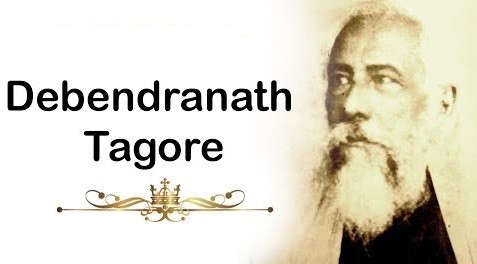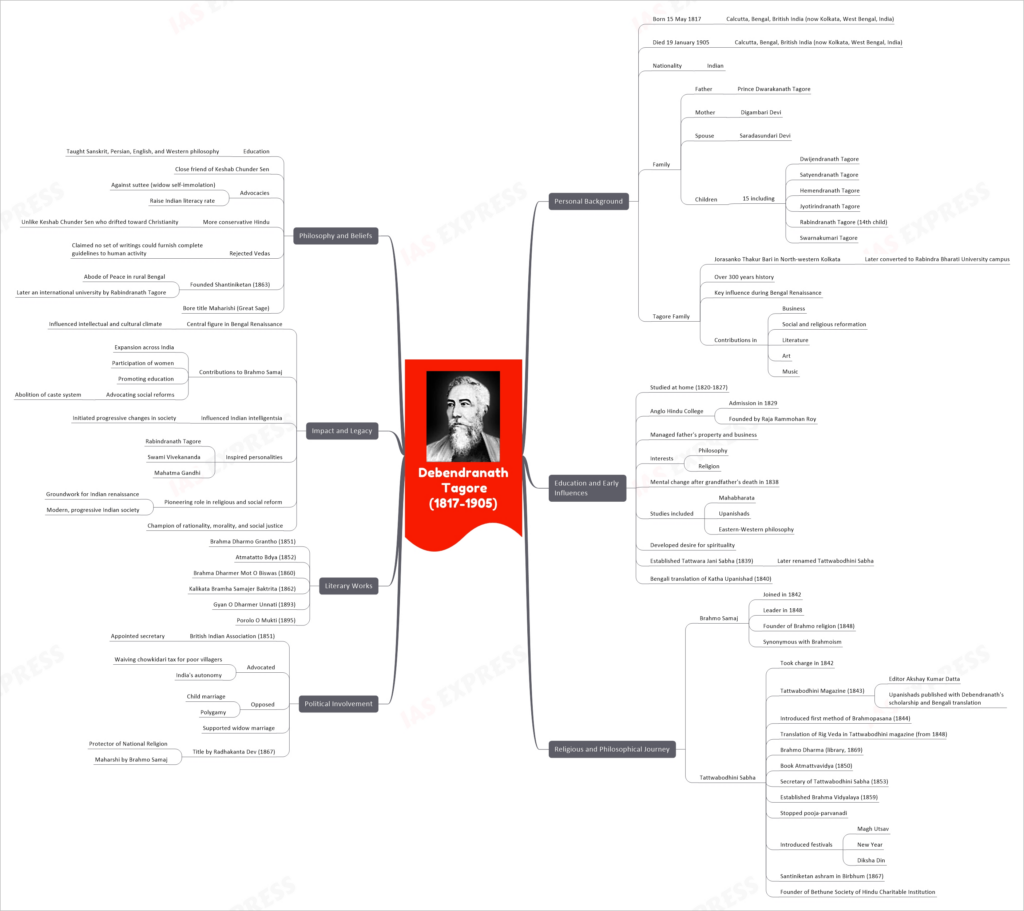Debendranath Tagore – A Trailblazer of the Bengal Renaissance

Debendranath Tagore was a prominent 19th-century Indian philosopher and religious reformer, known for his pivotal role in the Brahmo Samaj. Born into the influential Tagore family, his work significantly contributed to the Bengal Renaissance and he is remembered for his efforts in spiritual, social, and educational reforms in India.
This topic of “Debendranath Tagore – A Trailblazer of the Bengal Renaissance” is important from the perspective of the UPSC IAS Examination, which falls under General Studies Portion.
Personal Background
- Born: May 15, 1817, in Calcutta, Bengal, British India
- Died: January 19, 1905, in Calcutta, Bengal, British India
- Nationality: Indian
- Father: Prince Dwarakanath Tagore
- Mother: Digambari Devi
- Spouse: Saradasundari Devi
- Children: 15, including prominent figures like Dwijendranath Tagore, Satyendranath Tagore, Hemendranath Tagore, Jyotirindranath Tagore, and Rabindranath Tagore (the 14th child)
- Tagore Family: Associated with Jorasanko Thakur Bari in North-western Kolkata, later converted into the Rabindra Bharati University campus
- Boasting a history spanning over 300 years
- Significant influence during the Bengal Renaissance
- Contributions in business, social and religious reformation, literature, art, and music
Education and Early Influences
Formative Years
- Early education at home (1820-1827)
- Later attended the Anglo Hindu College, which was founded by Raja Rammohan Roy, in 1829
- Managed his father’s property and business
- Developed interests in philosophy and religion
- Underwent a profound transformation after his grandfather’s death in 1838
- Engaged in extensive studies, including the Mahabharata, Upanishads, and Eastern-Western philosophy
- Cultivated a deep desire for spirituality
Tattwabodhini Sabha and Literary Pursuits
- Established the Tattwara Jani Sabha in 1839, later renamed Tattwabodhini Sabha
- Introduced the Bengali translation of Katha Upanishad in 1840
- Pioneered the first method of Brahmopasana in 1844
- Published translations of the Rig Veda in the Tattwabodhini magazine starting from 1848
- Founded the Brahmo Dharma library in 1869
- Authored the book “Atmattvavidya” in 1850
- Served as the secretary of Tattwabodhini Sabha in 1853
- Established the Brahma Vidyalaya in 1859
- Initiated the discontinuation of traditional pooja-parvanadi rituals
- Introduced new festivals like Magh Utsav, New Year celebrations, and Diksha Din
- Founded the Santiniketan ashram in Birbhum in 1867
- Also played a role in founding the Bethune Society of Hindu Charitable Institution
Religious and Philosophical Journey
- Debendranath Tagore joined the Brahmo Samaj in 1842
- By 1848, he emerged as a leader and became synonymous with Brahmoism
- Established the Brahmo religion in 1848
- Took charge of the Tattwabodhini Sabha in the same year
- Launched the Tattwabodhini Magazine in 1843, with Akshay Kumar Datta as the editor
- Published Upanishads with Debendranath’s scholarship and Bengali translations
- Translated the Rig Veda, contributing to the magazine’s content
- His library, Brahmo Dharma, became a center for religious studies in 1869
- Advocated and propagated his philosophical ideas through his book “Atmattvavidya” in 1850
- Established the Brahma Vidyalaya in 1859 to promote religious education
- Brought about significant changes in religious practices, emphasizing rationality and morality
- Introduced the concept of Brahmopasana, a form of spiritual worship
Political Involvement
- Active member of the British Indian Association from 1851, where he served as secretary
- Advocated for waiving chowkidari tax for poor villagers
- Voiced his support for India’s autonomy
- Opposed regressive practices like child marriage and polygamy
- Championed the cause of widow marriage
- Bestowed with the title “Protector of National Religion” by Radhakanta Dev in 1867
- Honored with the title “Maharshi” by the Brahmo Samaj
Literary Works
- Not limited to religious and philosophical writings, Debendranath Tagore also made significant literary contributions
- Some of his notable works include:
- “Brahma Dharmo Grantho” (1851)
- “Atmatatto Bdya” (1852)
- “Brahma Dharmer Mot O Biswas” (1860)
- “Kalikata Bramha Samajer Baktrita” (1862)
- “Gyan O Dharmer Unnati” (1893)
- “Porolo O Mukti” (1895)
Impact and Legacy
- Debendranath Tagore stands as a central figure in the Bengal Renaissance, significantly influencing the intellectual and cultural climate of the time
- His contributions to the Brahmo Samaj were profound:
- Expansion of the Brahmo Samaj across India
- Encouragement of women’s participation in religious activities
- Promotion of education and social reforms, including the abolition of the caste system
- He inspired countless personalities, including Rabindranath Tagore, Swami Vivekananda, and Mahatma Gandhi
- His pioneering role in religious and social reform laid the groundwork for the Indian renaissance, contributing to the development of a modern, progressive Indian society
- He championed values of rationality, morality, and social justice throughout his life
Philosophy and Beliefs
Educational Endeavors
- Apart from his writings, Debendranath Tagore was an educator who taught Sanskrit, Persian, English, and Western philosophy
- He shared a close friendship with Keshab Chunder Sen, another prominent figure in the Brahmo Samaj
Advocacies and Belief System
- Advocated against regressive practices like suttee (widow self-immolation)
- Worked tirelessly to raise the Indian literacy rate
- Although more conservative than Keshab Chunder Sen, he remained rooted in Hindu traditions and did not drift towards Christianity
- Rejecting the Vedas, he believed that no single set of writings could provide comprehensive guidance for human activity
Shantiniketan: The Abode of Peace
- In 1863, Debendranath Tagore founded Shantiniketan, which means “Abode of Peace,” in rural Bengal
- This institution later evolved into an international university under the stewardship of his son, Rabindranath Tagore
- Debendranath Tagore earned the title of “Maharishi,” signifying his stature as a Great Sage
Debendranath Tagore’s life and work continue to inspire generations, and his legacy remains an integral part of India’s cultural and intellectual heritage. His contributions to religious and social reform, literature, and philosophy continue to resonate in the modern world, making him a true luminary of his time.



Who can read this with zoom ??